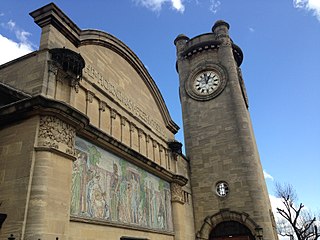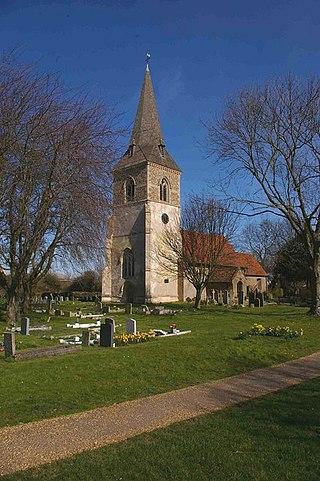
Leeds Castle is a castle in Kent, England, 7 miles (11 km) southeast of Maidstone. It is built on islands in a lake formed by the River Len to the east of the village of Leeds. It is a historic Grade I listed estate.

English Heritage is a charity that manages over 400 historic monuments, buildings and places. These include prehistoric sites, medieval castles, Roman forts, and country houses.

Cadw is the historic environment service of the Welsh Government and part of the Tourism and Culture group. Cadw works to protect the historic buildings and structures, the landscapes and heritage sites of Wales, to make them available for the public to visit, enjoy, and understand their significance. Cadw manages 127 state-owned properties and sites. It arranges events at its managed properties, provides lectures and teaching sessions, offers heritage walks, and hosts an online shop. Members of the public can become members of Cadw to gain membership privileges.

Haddenham is a village and civil parish in west Buckinghamshire, England. It is about 5 miles (8 km) south-west of Aylesbury and 4 miles (6 km) north-east of Thame in neighbouring Oxfordshire. At the 2011 Census, the population of the civil parish was 4,502.

The Horniman Museum and Gardens is a museum in Forest Hill, London, England. Commissioned in 1898, it opened in 1901 and was designed by Charles Harrison Townsend in the Modern Style. It has displays of anthropology, natural history and musical instruments, and is known for its large collection of taxidermied animals. The building is Grade II* listed.

Friends of Friendless Churches (FoFC) is a registered charity formed in 1957, active in England and Wales, which campaigns for and rescues redundant historic places of worship threatened by demolition, decay, or inappropriate conversion. As of April 2021, the charity owns 58 redundant churches or chapels, 29 of which are in England, and 29 in Wales.

Winterslow is a civil parish with a population of around 2,000, about 6 miles (10 km) northeast of Salisbury in Wiltshire, England, and lying south of the A30 London Road. It is sited on the Roman road between Old Sarum and Winchester.

Datchworth is a village and civil parish between the towns of Hertford, Stevenage and Welwyn Garden City in the county of Hertfordshire, England. Sited on the Roman road from St Albans to Puckeridge, the village has examples of Saxon clearings in several locations. Datchworth has a village green where there are two pubs and a sports club. There are three other pubs in the parish: The Horns at Bulls Green, The White Horse at Burnham Green and Three Horse Shoes at Hooks Cross. In the 2001 Census the population was 1,065, increasing to 1,524 at the 2011 Census.

Diseworth is a village and former civil parish, now in the parish of Long Whatton and Diseworth, in the North West Leicestershire district, in the English county of Leicestershire. It is south of East Midlands Airport and off Junction 23A of the M1 motorway.

Thomas Hardy's Cottage, in Higher Bockhampton, Dorset, is a small cob and thatch building that is the birthplace of the English author Thomas Hardy. He was born there in 1840 and lived in the cottage until he was aged 34—during which time he wrote the novels Under the Greenwood Tree (1872) and Far from the Madding Crowd (1874)—when he left home to be married to Emma Gifford.

St John the Baptist Church is located to the northeast of the village of Tunstall, Lancashire, England. It is an active Anglican parish church in the united benefice of East Lonsdale, in the deanery of Tunstall, the archdeaconry of Lancaster and the diocese of Blackburn. The benefice of East Lonsdale combines this church with St Peter, Leck, St Wilfrid, Melling, St James the Less, Tatham, The Good Shepherd, Lowgill, and Holy Trinity, Wray. The church is recorded in the National Heritage List for England as a designated Grade I listed building. Services are usually at 11:00 on 2nd & 4th Sundays, in rota with the sister church at Leck.

The Firs in Lower Broadheath, Worcestershire, England was the birthplace of Edward Elgar. The cottage now houses a museum administered by the National Trust. Edward Elgar was born at the house on 2 June 1857, and lived there for the first two years of his life. The museum comprises the Birthplace Cottage and its garden, and the modern Elgar Centre, opened in 2000, which houses further exhibitions and a function room.

The Historic Chapels Trust is a British Registered Charity set up to care for redundant non-Anglican churches, chapels, and places of worship in England. To date, its holdings encompass various nonconformist Christian denominations and Roman Catholic sites.

Cote Baptist Church stands in Shifford Road, Cote, 1 mile (2 km) to the east of Aston and 4 miles (6 km) to the east of Bampton, in Oxfordshire, England. It is a redundant Baptist chapel in the care of the Historic Chapels Trust, and is recorded in the National Heritage List for England as a designated Grade II* listed building.

Wainsgate Baptist Church is a redundant chapel standing in an elevated position above the town of Hebden Bridge, West Yorkshire, England. The chapel and its attached school are recorded in the National Heritage List for England as a designated Grade II* listed building. The chapel is managed by the Historic Chapels Trust.
The Shrine of Our Lady of Lourdes, Blackpool, stands in Whinney Heys Road, Blackpool, Lancashire, England. It is recorded in the National Heritage List for England as a designated Grade II* listed building, and now owned by Historic Chapels Trust. Locally it is simply known as 'The Shrine' or the 'Bishop's folly'. The 'White Church' is another Church building in Ansdell.

Horsham Unitarian Church is a Unitarian chapel in Horsham in the English county of West Sussex. It was founded in 1719 to serve the large Baptist population of the ancient market town of Horsham—home of radical preacher Matthew Caffyn—and the surrounding area. The chapel's congregation moved towards Unitarian beliefs in the 19th century, but the simple brick building continued to serve worshippers drawn from a wide area of Sussex. It is one of several places of worship which continue to represent Horsham's centuries-old tradition of Protestant Nonconformism, and is the town's second oldest surviving religious building—only St Mary's, the parish church, predates it. English Heritage has listed the chapel at Grade II for its architectural and historical importance.

Charterhouse, Coventry is a grade I listed building on London Road, Coventry, in the West Midlands of England.

Hare Street House is a Grade II* listed building in the hamlet of Hare Street that lies between Buntingford and Great Hormead in the East Hertfordshire district of Hertfordshire, England. It is mainly associated with the Roman Catholic priest and writer Robert Hugh Monsignor Benson, who owned the house from 1906 until his death in 1914.



















